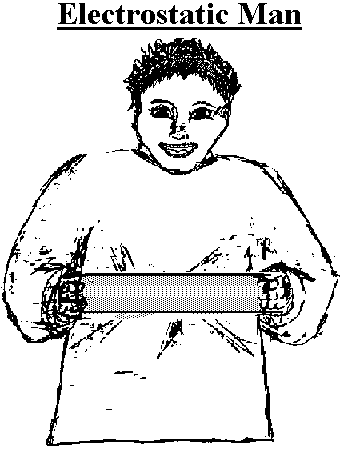
A volunteer stands on a piece of styrofoam or whiskey box with partition, in order to insulate him/her from the ground. He/she puts on a garbage bag jacket or cape. The garbage bag is charged by vigorously rubbing it with animal fur. Then the volunteer is handed a fluorescent light. It should light up momentarily.

Further information on Theory, Apparatus, Procedure, and Helpful Hints is available. The equipment for this demo is stored in Rockefeller room 302.
The word "static" comes from the Greek word meaning "standing" or "stationary". Static charge is formed when electrons are added or removed from a material. The electrons that cause static charges remain in one location, thus the charge is not moving. Static charges can be easily produced in materials such as rubber, plastic, glass, and fur. In this demonstration, the fur tends to lose electrons and become positively charged, whereas the plastic tends to gain electrons and take on a negative charge. When the person holds the light bulb, he/she discharges and lights the bulb.
The following equiptment is needed for this demonstration:
A volunteer stands on a piece of styrofoam or a whiskey box with a partition, in order to insulate him/her from the ground. He/she is wearing a garbage bag jacket or cape. The garbage bag is charged by vigorously rubbing it with animal fur. Then he is handed a fluorescent light. It should light up momentarily.